Rise of Extremism and Swadeshi Movement | History - Swadeshi Campaign in Tamil Nadu | 12th History : Chapter 2 : Rise of Extremism and Swadeshi Movement
Chapter: 12th History : Chapter 2 : Rise of Extremism and Swadeshi Movement
Swadeshi Campaign in Tamil Nadu
Swadeshi
Campaign in Tamil Nadu
Swadeshi
movement in Tamil Nadu, notably in Tirunelveli district, generated a lot of
attention and support. While the Swadeshi movement in Tamil Nadu had an all
India flavour, with collective anger against the British rule remaining the
common thread, it was also underpinned by Tamil - pride and consciousness.
There was a deep divide in the Tamilnadu congress between the moderates and the
extremists.
(a) Development of Vernacular Oratory
Initially,
the movement was more of a reaction to the partition of Bengal and regular
meetings were held to protest the partition. The speakers, in such meetings,
spoke mostly in the vernacular language to an audience that included students,
lawyers, and labourers at that time. The shift from English oratory to
vernacular oratory was a significant development of this time, which had a huge
impact on the mass politics in Tamil Nadu.
Swadeshi
meetings at the Marina beach in Madras were a regular sight. The Moore Market
complex in Madras was another venue utilised for such gatherings. During the
period (1905-1907) there are police reports calling students dangerous and
their activities as seditious. Europeans in public places were greeted by the
students with shouts of Vande Mataram. In 1907, Bipin Chandra Pal came to
Madras and his speeches on the Madras Beach electrified the audience and won
new converts to the nationalist cause. The visit had a profound impact all over
Tamil Nadu. The public speeches in the Tamil language created an audience which
was absent during the formative years of the political activities in Tamil
Nadu.
(b) V.O.C. and Swadeshi Steam Navigation Company (SSNC)
The Swadeshi movement in Tamil Nadu came
to national attention
in 1906 when V.O Chidambaram mooted the
idea of launching
a swadesh shipping venture in in opposition to the monopoly
of the British in navigation through the coast.
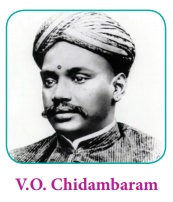
In 1906,
V.O.C. registered a joint stock company called The Swadeshi Steam Navigation
Company (SSNC) with a capital of Rs 10 Lakh, divided into 40,000 shares of Rs.
25 each.
Shares
were open only to Indians, Ceylonese and other Asian nationals. V.O.C. purchased
two steamships, S.S. Gallia and S.S. Lawoe. When in the other parts of India,
the response to Swadeshi was limited to symbolic gestures of making candles and
bangles, the idea of forging a Swadeshi Steam Navigation Company was really
spectacular. V.O.C invoked the rich history of the region and the maritime
glory of India’s past and used it as a reference point to galvanize the public
opinion in favour of a Swadeshi venture in the sea.
The
initiative of V.O.C. was lauded by the national leaders. Lokmanya Tilak wrote
about the success of the Swadeshi Navigation Company in his papers Kesari and Mahratta. Aurobindo Ghose also lauded the Swadeshi efforts and
helped to promote the sale of shares of the company. The major shareholders
included Pandithurai and Haji Fakir Mohamed.
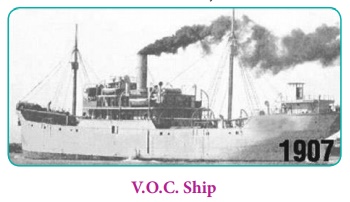
The
initial response of the British administration was to ignore the Swadeshi
company. As patronage for Swadeshi Company increased, the European officials
exhibited blatant bias and racial partiality against the Swadeshi steamship.
(c) The Coral Mill Strike
After
attending the session of the Indian National Congress at Surat, V.O.C. on his
return decided to work on building a political organisation. While looking for
an able orator, he came across Subramania Siva, a swadeshi preacher. From
February to March 1907, both the leaders addressed meetings almost on a daily
basis at the beach in Tuticorin, educating the people about swadeshi and the
boycott campaign. The meetings were attended by thousands of people. These
public gatherings were closely monitored by the administration.
In 1908,
the abject working and living conditions of the Coral Mill workers attracted
the attention of V.O.C and Siva. In the next few days, both the leaders
addressed the mill workers. In March 1908, the workers of the Coral Cotton
Mills, inspired by the address went on strike. It was one of the earliest
organised labour agitations in India.
The
strike of the mill workers was fully backed by the nationalist newspapers. The
mill owners, however, did not budge and was supported by the government which
had decided to suppress the strike. To further increase the pressure on the
workers, the leaders were prohibited from holding any meetings in Tuticorin.
Finally, the mill owners decided to negotiate with the workers and concede
their demands.
This
victory of the workers generated excitement among the militants in Bengal and
it was hailed by the newspapers in Bengal. For instance, Aurobindo Ghosh’s
Bande Matram hailed the strike as “forging a bond between educated class and
the masses, which is the first great step towards swaraj…. Every victory of
Indian labour is a victory for the nation….”
(d) Subramania Bharati: Poet and Nationalist
The
growth of newspapers, both in English and Tamil language, aided the swadeshi
movement in Tamil Nadu. G. Subramaniam was one of the first among the leaders to use newspapers
to spread the nationalist message across a larger audience. Subramaniam, along
with five others, founded The Hindu
(in English) and Swadesamitran (which
was the first ever Tamil daily). In 1906 a book was published by Subramaniam to
condemn the British actions during the Congress Conference in Barsal. Swadesamitran extensively reported
nationalist activities, particularly
the news regarding V.O.C. and his speeches in Tuticorin.
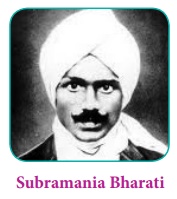
Subramania
Bharati became the sub-editor of Swadesamitran
around the time (1904) when Indian nationalism was looking for a fresh
direction. Bharati was also editing Chakravartini,
a Tamil monthly devoted to the cause
of Indian women.
Two
events had a significant impact on Subramania Bharati. A meeting in 1905 with
Sister Nivedita, an Irish woman and a disciple of Vivekananda, whom he referred
to as Gurumani (teacher), greatly inspired his nationalist ideals. The churning
within the Congress on the nature of engagement with the British rule was also
a contributory factor. As discussed earlier in this lesson, the militants
ridiculed the mendicancy of the moderates who wanted to follow the
constitutional methods. Bharati had little doubt, in his mind, that the British
rule had to be challenged with a fresh approach and methods applied by the
militant nationalists appealed to him more. For instance, his fascination with
Tilak grew after the Surat session of the Congress in 1907. He translated into
Tamil Tilak’s Tenets of the New Party and a booklet on the
Madras militants’ trip to the Surat
Congress in 1907. Bharati edited a Tamil weekly India, which became the voice of the radicals.
(e) Arrest and imprisonment of V.O.C. and Subramania Siva
On March 9, 1907, Bipin Chandra Pal was released from prison after serving a six-month jail sentence.The swadeshi leaders in Tamil Nadu planned to celebrate the day of his release as ‘Swarajya Day’ in Tirunelveli. The local administration refused permission. V.O.C., Subramania Siva and Padmanabha Iyengar defied the ban and went ahead. They were arrested on March 12, 1908, on charges of sedition.
The local
public, angered over the arrest of the prominent swadeshi leaders, reacted
violently. Shops were closed in a general show of defiance. The municipality
building and the police station in Tirunelveli were set on fire. More
importantly, the mill workers came out in large numbers to protest the arrest
of swadeshi leaders. After a few incidents of confrontation with the protesting
crowd, the police open fired, and four people were killed.
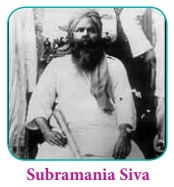
On 7 July
1908, V.O.C. and Subramania Siva were found guilty and imprisoned on charges of
sedition. Siva was awarded a sentence of 10 years of transportation for his
seditious speech whereas V.O.C. got a life term (20 years) for abetting him.
V.O.C. was given another life sentence for his own seditious speech. This
draconian sentence reveals how seriously the Tirunelveli agitation was viewed by
the government.
In the
aftermath of this incident, the repression of the British administration was
not limited to the arrest of a few leaders. In fact, people who had actively
participated in the protest were also punished and a punitive tax was imposed
on the people of Tirunelveli and Tuticorin.
Excerpts from the Judgment in the case of King Emperor versus
V.O.C. and Subramania Siva (4 November 1908).“It seems to me that sedition at
any time is a most serious offense. It is true that the case is the first of
its kind in the Presidency, but the present condition of other Presidencies
where the crime seems to have secured a foothold would seem to indicate that
light sentences of imprisonment of a few months or maybe a year or two are
instances of misplaced leniency. ...The first object of a sentence is that it
shall be deterrent not to the criminal alone but to others who feel any
inclination to follow his example. Here we have to deal with a campaign of
sedition which nearly ended in revolt. The accused are morally responsible for
all the lives lost in quelling the riots that ensured on their arrest”.
(f) Ashe Murder
Repression
of the Swadeshi efforts in Tuticorin and the subsequent arrest and humiliation
of the swadeshi leaders generated anger among the youth. A plan was hatched to
avenge the Tirunelveli event. A sustained campaign in the newspapers about the
repressive measures of the British administration also played a decisive role
in building people’s anger against the administration.
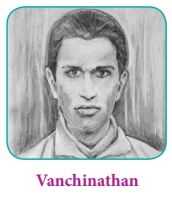
In June
1911, the collector of Tirunelveli, Robert Ashe, was shot dead at Maniyachi
Railway station by Vanchinathan. Born in the Travancore state in 1880, he was
employed as a forest guard at Punalur in the then Travancore state. He was one
of the members of a radical group called Bharata Mata Association. The aim of
the association was to kill the European officers and inspire Indians to
revolt, which they believed would eventually lead to Swaraj. Vanchinathan was
trained in the use of a revolver, as part of the mission, by V.V. Subramaniam
in Pondicherry.
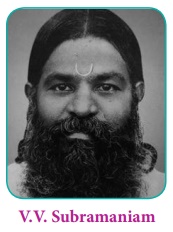
After shooting Ashe
at the Maniyachi Junction, Vanchinathan shot himself with the same pistol. A
letter was found in his pocket which helps to understand the strands of
inspiration for the revolutionaries like Vanchinathan.
The aftermath of the Assassination
During
the course of the trial, the British government was able to establish that
V.V.S and other political exiles in Pondicherry were in close and active
association with the accused in the Ashe murder conspiracy. The colonial
administration grew more suspicious with the Pondicherry groups and their
activities. Such an atmosphere further scuttled the possibility of
nationalistic propaganda and their activities in Tamil Nadu. As a fall-out of
the repressive measure taken by the colonial government, the nationalist
movement in Tamil Nadu entered a period of lull and some sort of revival
happened only with the Home Rule Movement in 1916.
Related Topics